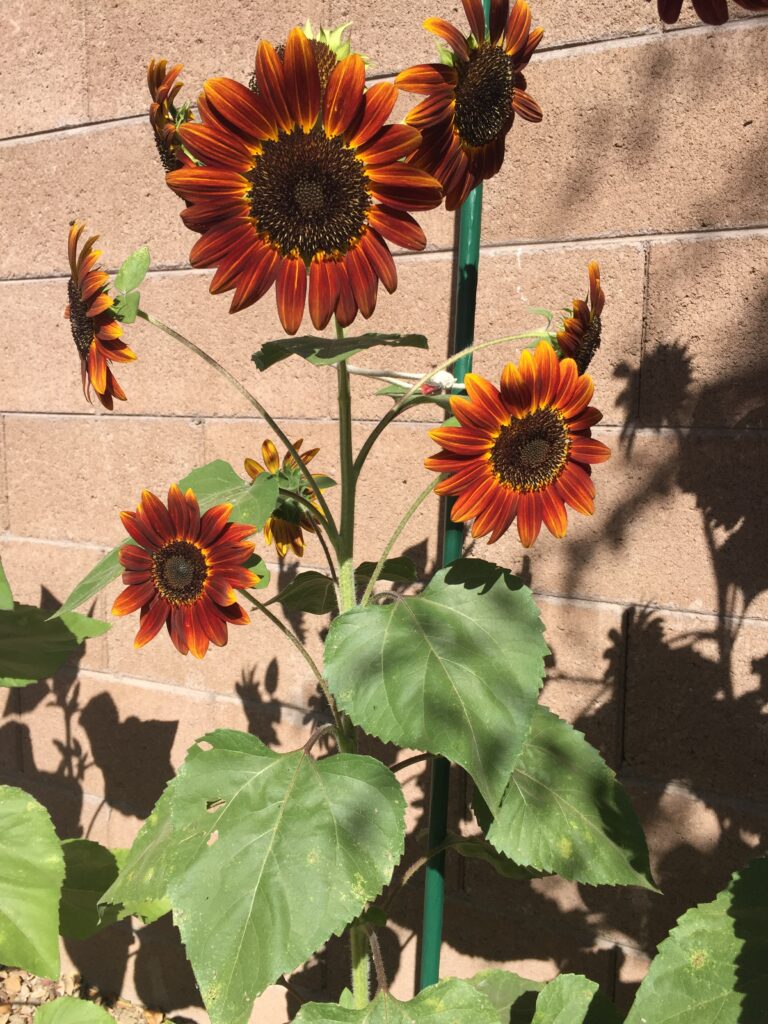
Plant sunflowers for a garden that will make you smile!
Find a sunny place with well-drained soil and plant seeds in early spring or fall, placing the pointy end of the seed down and topping it with one inch of soil. Keep the soil moist and seedlings should appear in 7-10 days. If starting them in pots, transplant to the ground when two sets of leaves appear.
A good idea is to plant many in stages as the blooms only last one to two weeks. For the longest lasting displays, cut flowers in the morning. This will encourage new buds to form.
It is so interesting to watch sunflowers as they turn toward the sun. At dusk they shift to the East waiting for the morning light. Their scientific name is Helianthus annulus from the Greek word for sun “helios” and flower “anthos.” They belong to the daisy family known as Asteraceae.
Native Americans have grown sunflowers for food, oil and flour for centuries. In fact, sunflower seeds were found in Mexico dating back to 3000 B.C. The seeds are full of fiber, high in protein and contain antioxidants. What a perfect snack! This truly American crop was transported to Europe by the Spanish in the 1500s and is now grown around the world. North Dakota produces the most sunflowers of any state in the United States.
Bees, butterflies and hummingbirds are important pollinators attracted to sunflowers. Bees will stay on the flower’s center for several minutes catching pollen on their hind legs.
Sunflowers are usually yellow with a brown center, however there are many other varieties. As many as 2,000 tiny flowers may grow in the center, later becoming seeds.
Children love the bright yellow “Dwarf Teddy Bear” variety, which is perfect for containers. It features sturdy stems, grows 2 inches to 3 inches tall and has edible petals and seeds. The flowers resemble pompoms!
For plump seeds, try “Mammoth Gray Stripe.” The large 20-inch heads can be harvested when the petals dry out and seeds are rounded. This variety can reach 12 feet tall and needs to be staked. Harvest the seeds when the back of the flower head turns brown.

“Chianti Hybrid” has lovely wine-colored petals with gold flecks in them. It is a branched and pollenless sunflower that can reach up to 5 feet in height. The flower heads are 3 inches to 4 inches wide, making this variety a dramatic cut flower. A similar type is “Fire Catcher,” with its brilliant shades of red and yellow.
Sunflowers absorb toxic waste by taking it up in the leaves and stems of the plant. Millions of these flowers were planted after the nuclear disasters in Fukushima, Japan and Chernobyl, Ukraine. (It is Ukraine’s national flower and has become a symbol of solidarity since its invasion by Russia.) In fact, the symbol of a nuclear weapons-free world is the sunflower.
No wonder sunflowers make us smile!
Alice Batsche is a University of Arizona Master Gardener.
This column was first published in the June edition of InMaricopa magazine. It was incorrectly noted that she was a former member of the University of Arizona Master Gardener program when she is in fact a current Master Gardener.


![Maricopa’s ‘TikTok Rizz Party,’ explained One of several flyers for a "TikTok rizz party" is taped to a door in the Maricopa Business Center along Honeycutt Road on April 23, 2024. [Monica D. Spencer]](https://www.inmaricopa.com/wp-content/uploads/2024/04/spencer-042324-tiktok-rizz-party-flyer-web-218x150.jpg)



![Locals find zen with Earth Day drum circle Lizz Fiedorczyk instructs a drum circle at Maricopa Community Center April 22, 2024. [Brian Petersheim Jr.]](https://www.inmaricopa.com/wp-content/uploads/2024/04/PJ_3922-Enhanced-NR-218x150.jpg)


![Shred-A-Thon to take place tomorrow An image of shredded paper. [Pixabay]](https://www.inmaricopa.com/wp-content/uploads/2024/03/shredded-paper-168650_1280-218x150.jpg)


![Alleged car thief released without charges Phoenix police stop a stolen vehicle on April 20, 2024. [Facebook]](https://www.inmaricopa.com/wp-content/uploads/2024/04/IMG_5040-218x150.jpg)



![City gave new manager big low-interest home loan City Manager Ben Bitter speaks during a Chamber of Commerce event at Global Water Resources on April 11, 2024. Bitter discussed the current state of economic development in Maricopa, as well as hinting at lowering property tax rates again. [Monica D. Spencer]](https://www.inmaricopa.com/wp-content/uploads/2024/04/spencer-041124-ben-bitter-chamber-property-taxes-web-100x70.jpg)